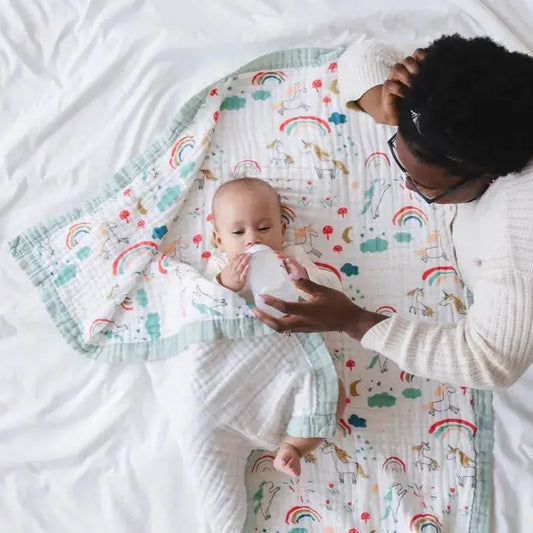When my daughter Airah was a baby, she had sensitive skin that flared up constantly — dry patches, rough cheeks, red bumps out of nowhere. I tried switching detergents, changing lotions, and even altering bath routines. But nothing worked — until I realized the issue might be her baby eczema blanket and everything else touching her skin.
This guide is a reflection of what actually helped soothe Airah’s eczema and protect her delicate skin. It’s a mix of gentle skincare tips, breathable fabrics, and a lot of trial and error — and I hope it helps your baby find relief too.
1. Fabrics Matter — More Than I Realized
The real breakthrough came when I started paying attention to Airah’s blankets, clothing, and bedding. I didn’t realize how much irritation came from materials I assumed were baby-safe — like polyester trims or fleece pajamas.
What to Look For:
- 100% cotton, especially muslin cotton
- Breathable layers that don’t trap heat
- Free from harsh dyes, chemical softeners, or synthetic blends
- Eczema-safe baby blanket
Studies confirm it too: cotton is widely recommended by dermatologists for eczema-prone babies because it's breathable, hypoallergenic, and soft on inflamed skin (HappySkinDermatology, MedicalNewsToday).
2. Why I Created My Own Blanket
I was shocked by how hard it was to find a 100% cotton baby blanket that was actually right for sensitive skin.
- The 100% cotton options were too thin, like swaddle blankets.
- The 10-layer quilts I tried were too heavy, especially since Airah liked sleeping with the blanket near her face — which made me nervous.
- Most “breathable” blankets were bamboo-cotton blends or had synthetic layers.
- Even 4-layer muslin blankets weren’t warm enough at night.
That’s why I created Snuggle Buds — a 6-layer muslin cotton baby eczema blanket that’s not too heavy, not too light, just right. It keeps your baby cozy without overheating and is safe even for sensitive little ones like mine.
3. Gentle Bathing (and Oat Soaks!) Made a Big Difference
I used to over-bathe Airah thinking it would help keep irritants off her skin. But long baths and scented cleansers actually stripped away her natural oils and made things worse.
What Helped Our Bath Routine:
- Short baths (5–10 mins max) with lukewarm water
- Fragrance-free, gentle cleansers
- Pat-drying with soft towels — no scrubbing
- Moisturizing immediately after while skin was still damp
We also added Ella Ola’s Oatmeal Bath Soak (shop here) a few times a week, which helped soothe redness and calm irritation. It’s gentle, fragrance-free, and perfect for eczema-prone skin.
4. Moisturize Like It’s a Ritual
Whether Airah’s skin looked irritated or not, we stayed consistent with daily moisturizing — and it helped prevent new flare-ups.
What We Used:
- Tubby Todd All Over Ointment (get it here) — our go-to miracle product for flare-ups
- Applied right after bath while skin was damp
- Focused on knees, elbows, cheeks, and neck creases
- Carried a mini version in the diaper bag for touch-ups
This ointment was the one thing I reordered again and again — it gave Airah noticeable relief, and I always recommend it to other moms.
5. A Humidifier Helped While She Slept
Dry indoor air was another hidden trigger. Especially during colder months or in rooms with heaters, Airah’s skin would dry out fast.
Adding a cool-mist humidifier helped us maintain moisture in the room — especially during sleep. It supported her skin barrier and prevented overnight dryness.
We used this one from Amazon — compact, quiet, and easy to clean.
6. Watch for Hidden Irritants
Some of the worst culprits were hiding in plain sight — products that looked “baby safe” but weren’t eczema-safe at all.
⚠️ We Learned to Avoid:
- Scented wipes
- Lotions with essential oils or synthetic fragrances
- Laundry detergents with brighteners or softeners
- Fleece or polyester-heavy pajamas and stuffed animals
We switched to “free & clear” everything and simplified as much as possible — and it helped us track triggers more easily.
From One Mom to Another…
If you’re deep in the sensitive skin journey, I know how frustrating it can feel. You’re doing so much right, even when it doesn’t feel like it.
What helped me most was simplifying. Choosing breathable fabrics. Building a gentle routine. Being intentional with every product and touchpoint.
And when I couldn’t find a baby eczema blanket I truly trusted? I made one.
Now, Snuggle Buds exists because my baby needed it — and maybe yours does too.
Try the Blanket That Changed Everything
Our 6-layer 100% muslin cotton baby eczema blankets are:
-
Designed for sensitive skin
-
Free from harsh dyes and synthetic blends
-
Soft, breathable, and never too heavy
🎁 Use code WELCOME10 for 10% off your first order
➡️ Shop Snuggle Buds Bestsellers
FAQ: Baby Eczema & Skincare Tips
Q1. What’s the best fabric for eczema-prone babies?
100% muslin cotton is a top choice. It’s soft, breathable, and recommended by dermatologists for its hypoallergenic nature — making it perfect for a baby eczema blanket or everyday clothing.
Q2. How often should I bathe a baby with eczema?
Stick to short baths 2–3 times a week with lukewarm water and a gentle, fragrance-free cleanser.
Q3. Can blankets or bedding cause irritation?
Yes — heavy or synthetic materials can trap heat and sweat, triggering flare-ups. Opt for lightweight, breathable layers like a baby eczema blanket made with muslin cotton to reduce irritation and keep your baby comfortable.
Q4. Do humidifiers really help with baby eczema?
Yes! They help keep moisture in the air, especially during sleep, which prevents skin from drying out and cracking overnight.
Affiliate Disclosure: This post includes a few affiliate links — which means I may earn a small commission if you purchase through them, at no extra cost to you. I only share products we’ve genuinely used and loved in our journey with sensitive skin.






